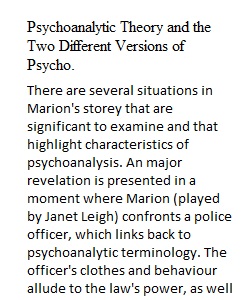


Q Using one of the critical theories from Module 4.4 as a lens, describe how you could interpret the two film versions you've selected for Essay #2 from that approach. What are the key aspects involved in the theory? How could you apply some of the questions in the Critics Questions handout and the Theory Chart to help you interpret/analyze the film? What should you consider when utilizing this theory as a critical lens for the two versions of the story? What kinds of questions do you need to answer to view the films through this lens? What would you look for, how would you look for it, and why? Give a couple of specific examples from the two versions of the films that you think would best be used to illustrate how you could apply the same critical theory lens and what meaning(s) you get out of comparing the examples from the films through using this critical theory approach. After you've posted your response, look through your classmates' posts and give feedback and advice to one of them--suggest questions they could explore, weigh in on how you might apply that lens to the films, say what you think is working best about their approach and what they still need to consider.
View Related Questions